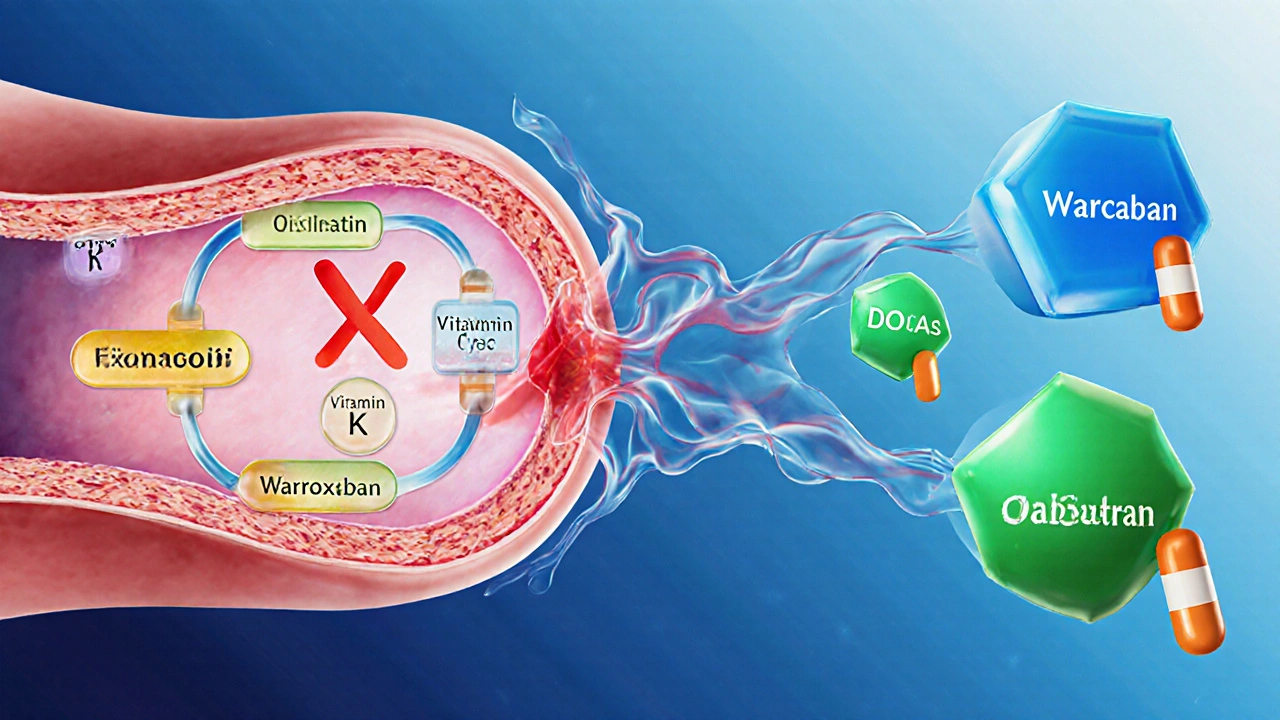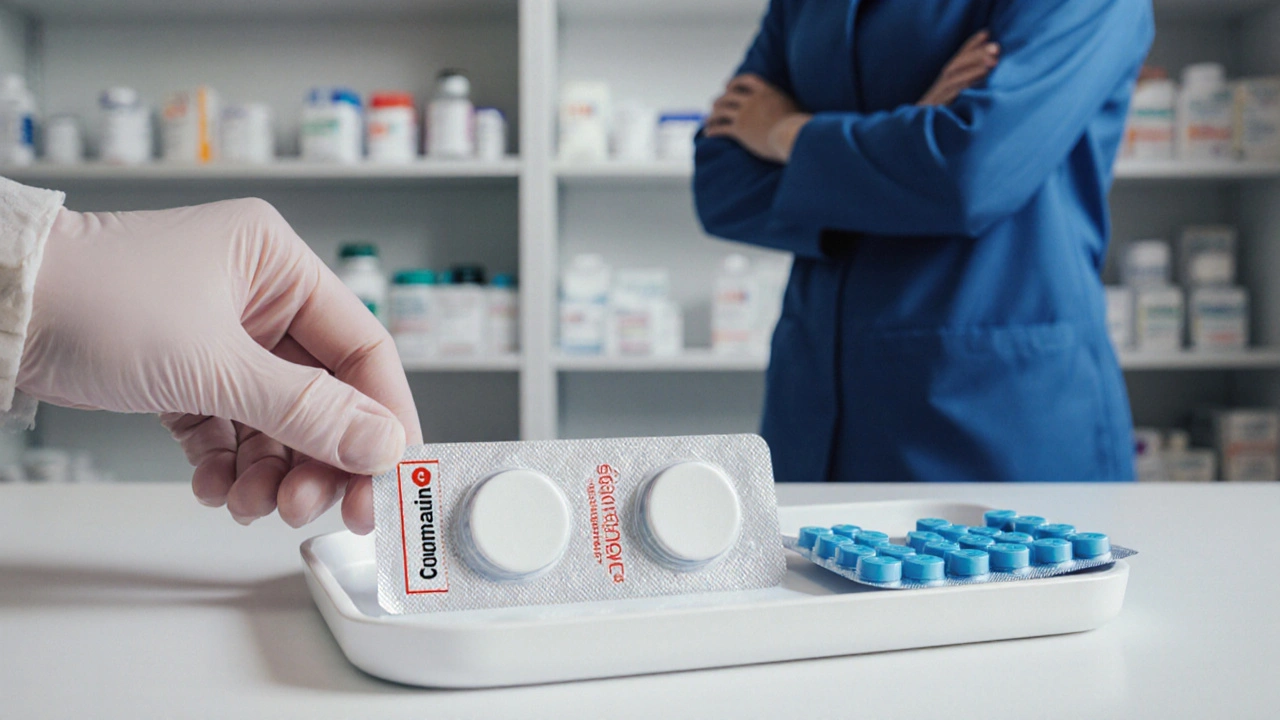Anticoagulant Selection Tool
Select Your Patient Factors
If you’ve been prescribed Warfarin alternatives, you probably wonder whether the newer pills really beat the old‑school warfarin (sold as Coumadin). The answer depends on the condition you’re treating, your kidney function, how much monitoring you can handle, and even your budget. Below you’ll find a plain‑English rundown that lets you weigh the pros and cons without needing a medical textbook.
Key Takeaways
- Warfarin requires regular INR checks; DOACs (like apixaban or rivaroxaban) do not.
- DOACs have faster onset, fewer food‑drug interactions, and specific reversal agents for most.
- Kidney impairment can limit the use of certain DOACs, while warfarin is safer for severe renal failure.
- Cost varies: generics of warfarin are cheap, but many insurers now cover DOACs without large co‑pays.
- Clinical guidelines recommend DOACs for most non‑valvular atrial fibrillation and venous thromboembolism, but warfarin remains first‑line for mechanical heart valves and severe antiphospholipid syndrome.
Understanding Warfarin (Coumadin)
Warfarin is a vitamin K antagonist that interferes with clotting factor synthesis, thereby thinning the blood. In the U.S. and UK it is marketed under the brand name Coumadin. Because its effect varies with diet, genetics, and other medicines, clinicians monitor its activity using the International Normalized Ratio (INR). The therapeutic INR window typically sits between 2.0 and 3.0 for most indications, but occasional patients need a higher range.
Warfarin’s half‑life is long (≈40hours), which means dose adjustments take days to stabilize. It also has a well‑known antidote-vitaminK-which can reverse anticoagulation quickly if bleeding occurs.

Direct Oral Anticoagulants (DOACs) Overview
The term direct oral anticoagulant, abbreviated DOAC, groups four main agents that act directly on specific clotting factors. They were introduced between 2010 and 2015 and have reshaped how doctors treat atrial fibrillation (AF) and venous thromboembolism (VTE).
Apixaban is a factorXa inhibitor taken twice daily. It boasts a low bleeding risk in head‑to‑head trials and can be reversed with andexanet alfa.
Rivaroxaban also blocks factorXa but is usually dosed once daily, making it convenient for patients who dislike multiple pills. A specific reversal agent, andexanet alfa, works for rivaroxaban as well.
Dabigatran is a direct thrombin (factorIIa) inhibitor. It is given twice daily and can be reversed with idarucizumab, a monoclonal antibody that works within minutes.
Edoxaban is another factorXa inhibitor, typically taken once daily. Its reversal relies on andexanet alfa, though the drug is less widely used in the UK.
All DOACs have predictable pharmacokinetics, meaning routine blood monitoring is unnecessary for most patients. However, kidney function (eGFR) must be checked because several agents are cleared renally.
Side‑by‑Side Comparison
| Attribute | Warfarin (Coumadin) | Apixaban | Rivaroxaban | Dabigatran | Edoxaban |
|---|---|---|---|---|---|
| Mechanism | VitaminK antagonist | FactorXa inhibitor | FactorXa inhibitor | Direct thrombin inhibitor | FactorXa inhibitor |
| Typical dosing | Once daily (adjusted) | 5mg twice daily | 20mg once daily | 150mg twice daily | 60mg once daily |
| Monitoring needed? | Yes - INR 2‑3 | No | No | No | No |
| Renal clearance | Minimal | ~27% | ~33% | ~80% | ~50% |
| Reversal agent | VitaminK, PCC | Andexanet alfa | Andexanet alfa | Idarucizumab | Andexanet alfa (off‑label) |
| Major drug interactions | Many (CYP2C9, foods) | Moderate (P‑gp, CYP3A4) | Moderate (P‑gp, CYP3A4) | Moderate (P‑gp) | Moderate (P‑gp, CYP3A4) |
| FDA/EMA approval year | 1959 (warfarin), 1995 (Coumadin) | 2012 | 2011 | 2010 | 2015 |
| Typical cost (UK) | £0.10 per tablet (generic) | £3‑£4 per tablet | £3‑£4 per tablet | £3‑£4 per tablet | £3‑£4 per tablet |
When Warfarin Still Makes Sense
Despite the convenience of DOACs, there are clinically important niches where warfarin remains the drug of choice. Patients with mechanical heart valves, severe antiphospholipid syndrome, or those on chronic dialysis often stay on warfarin because the evidence for DOAC safety in those groups is limited. Additionally, if a patient cannot afford the higher price of DOACs and has reliable access to INR testing, warfarin can be a cost‑effective solution.

Choosing the Right Anticoagulant: Decision Checklist
- Indication: Is the indication non‑valvular AF or VTE? If yes, a DOAC is usually preferred.
- Renal function: Check eGFR. If <30mL/min, consider warfarin or a dose‑adjusted DOAC (e.g., apixaban).
- Monitoring capacity: Can the patient attend weekly or monthly INR clinics? If not, a DOAC avoids that burden.
- Drug‑interaction profile: Review current meds. Strong CYP3A4 or P‑gp inhibitors may tip the scales toward warfarin.
- Reversal needs: For patients at high bleeding risk or scheduled for urgent surgery, pick an agent with an available specific antidote (andexanet alfa or idarucizumab).
- Cost & insurance: Compare generic warfarin price vs. DOAC co‑pay. Some NHS formularies now list DOACs as first‑line due to lower monitoring costs.
Common Pitfalls and How to Avoid Them
Skipping INR checks: Even with home testing, missing a single INR can let the clotting risk rise sharply. Set calendar reminders.
Ignoring dietary vitaminK: Sudden changes (e.g., leafy greens binge) can swing INR. Keep diet steady or discuss modifications with the clinician.
Assuming all DOACs are identical: Renal clearance varies widely; dabigatran is the most renal‑dependent, so it may be unsuitable for older patients with reduced kidney function.
Over‑relying on reversal agents: They are expensive and not always stocked in smaller hospitals. Always have a backup plan, such as covered by a specialized anticoagulation clinic.
Frequently Asked Questions
Can I switch from warfarin to a DOAC without a wash‑out period?
Yes, most guidelines advise stopping warfarin when the INR falls below 2.0, then starting the DOAC at the usual dose. No additional wash‑out is needed because DOACs act quickly.
What if I miss a dose of my DOAC?
Take the missed dose as soon as you remember if it’s within 12hours of the scheduled time. If it’s been longer, skip it and resume the regular schedule-don’t double‑dose.
Are DOACs safe during pregnancy?
No. Both warfarin and DOACs cross the placenta and can cause fetal abnormalities. Low‑molecular‑weight heparin is the preferred agent for pregnant patients.
How often should kidney function be checked on a DOAC?
At least annually, or more often if you have chronic kidney disease, diabetes, or are over 75years old. Your doctor may order eGFR every 6‑12months.
Which anticoagulant has the lowest risk of major bleeding?
Large meta‑analyses show apixaban typically has the lowest rates of intracranial hemorrhage compared with warfarin and other DOACs, especially in patients over 80years.

johnson mose
October 12, 2025 AT 04:21
Warfarin's old‑school charm still has a place.
Charmaine De Castro
October 19, 2025 AT 03:01
When you weigh the pros and cons of warfarin versus DOACs, it helps to start with the indication. For non‑valvular atrial fibrillation or a straightforward VTE, a DOAC often wins on convenience and bleeding risk. But mechanical heart valves and antiphospholipid syndrome still tip the scales toward warfarin because the evidence base is stronger there. Renal function is another gatekeeper – severe impairment (<30 mL/min) usually shuts the DOAC door. And don’t forget cost: if the budget is tight, warfarin’s cheap price tag may be decisive.
Mark Mendoza
October 26, 2025 AT 01:41
The choice between a vitamin‑K antagonist and a direct oral anticoagulant is more than a checklist; it’s a microcosm of personalized medicine. 🧠 You balance pharmacokinetics, patient lifestyle, and the ever‑present specter of bleeding. A patient who can sit down for weekly INR checks might appreciate warfarin’s reversibility, yet that same patient might tire of the dietary dance. Conversely, a busy professional with stable renal function often relishes the “set‑and‑forget” nature of apixaban or rivaroxaban. Remember, no drug is a one‑size‑fits‑all, and shared decision‑making stays king. In the end, the best drug is the one the patient will actually take as prescribed. Keep the conversation open and revisit the plan as conditions evolve.
Dan Tourangeau
November 2, 2025 AT 00:21
Spot on, Charmaine – I’d add that many clinics now offer point‑of‑care INR testing, which can soften the monitoring burden for warfarin users.
Bernard Valentinetti
November 8, 2025 AT 23:01
In the grand tapestry of anticoagulant pharmacotherapy, warfarin stands as a venerable stalwart, its legacy etched in decades of clinical experience.
Conversely, the direct oral anticoagulants, a constellation of apixaban, rivaroxaban, dabigatran and edoxaban, herald a newer epoch of convenience.
One must, however, not be seduced solely by the allure of convenience, for the pharmacodynamic subtleties demand rigorous scrutiny.
Renal clearance, for instance, serves as a critical arbiter; patients with eGFR below 30 mL/min are effectively excluded from most DOAC regimens.
Moreover, the specter of cost cannot be dismissed in a healthcare environment where drug pricing oscillates wildly.
Warfarin, with its modest price tag, remains the darling of fiscally constrained systems.
Yet, the necessity of regular INR monitoring imposes a logistical choreography that may prove burdensome.
The dietary interactions, while manageable, introduce an additional variable that can perturb therapeutic stability.
DOACs, on the other hand, eschew routine monitoring, thereby liberating both patient and provider from the cyclic laboratory cadence.
Their fixed dosing, albeit appealing, obscures the nuance required in special populations such as the elderly or those with fluctuating hepatic function.
When confronting mechanical heart valves, the evidence unequivocally reinstates warfarin as the agent of choice, given the paucity of robust data supporting DOAC efficacy in this niche.
Similarly, antiphospholipid syndrome, particularly in high‑titer triple‑positive cases, mandates the precision of vitamin‑K antagonism.
In the realm of venous thromboembolism prophylaxis, studies have demonstrated comparable, if not superior, outcomes with apixaban, provided renal function is adequate.
Nonetheless, the physician must remain vigilant for idiosyncratic bleeding patterns, as the reversal agents for DOACs, though available, are not universally accessible.
Thus, the decision matrix is a mosaic of indication, renal function, cost, monitoring capacity, and patient preference.
In sum, the practitioner must wield both the scalpel of evidence and the brush of compassion to sculpt an anticoagulation strategy that aligns with the individual’s clinical portrait.
Kenneth Obukwelu
November 15, 2025 AT 21:41
The drama of choosing a blood thinner is akin to selecting a lead actor for a high‑stakes thriller – you need the right charisma, stamina, and the ability to handle the pressure of the spotlight.
Josephine hellen
November 22, 2025 AT 20:21
Embarking on the anticoagulant journey can feel like setting sail on uncharted waters, but with the right compass you’ll navigate safely.
First, celebrate the fact that we have multiple effective options rather than being forced into a single path.
Warfarin, the seasoned mariner, brings decades of real‑world data and a flexible dosing regimen that can be fine‑tuned with INR results.
Direct oral anticoagulants, the sleek modern yachts, glide smoothly without the need for routine blood draws.
When your patient has stable kidney function above 60 mL/min, the DOACs shine, offering lower intracranial bleed rates.
If renal function dips into the 30‑40 mL/min range, you’ll want to pause and reassess dose adjustments, perhaps favoring warfarin.
Cost considerations are like the tide – they can lift or lower your choices depending on insurance coverage and co‑pay structures.
For those on a tight budget, warfarin’s inexpensive profile can be a lifesaver, especially when monitoring services are readily available.
Conversely, for patients who cannot attend frequent clinic visits, the convenience of a DOAC may outweigh the modest price difference.
Don’t forget the special cases: mechanical heart valves, severe antiphospholipid syndrome, and chronic dialysis remain strongholds of warfarin therapy.
In these scenarios, the evidence base still leans heavily toward the vitamin‑K antagonist, providing clinicians with confidence.
Patient education is the wind in your sails – teach them about diet, drug interactions, and the signs of bleeding.
Empowering patients with knowledge ensures adherence, whether they’re checking INR numbers or simply taking a daily pill.
Regular follow‑up appointments act as your lighthouse, guiding adjustments and catching potential issues early.
Remember, the ultimate goal is to keep blood from clotting where it shouldn’t, while minimizing bleeding where it might.
Stay optimistic, stay informed, and you’ll chart a course that keeps your patients safe and thriving.
Ria M
November 29, 2025 AT 19:01
Indeed, the therapeutic odyssey is as epic as any mythic saga – each decision writes a new stanza in the patient’s health narrative.
Michelle Tran
December 6, 2025 AT 17:41
DOACs are pretty sweet 😎.